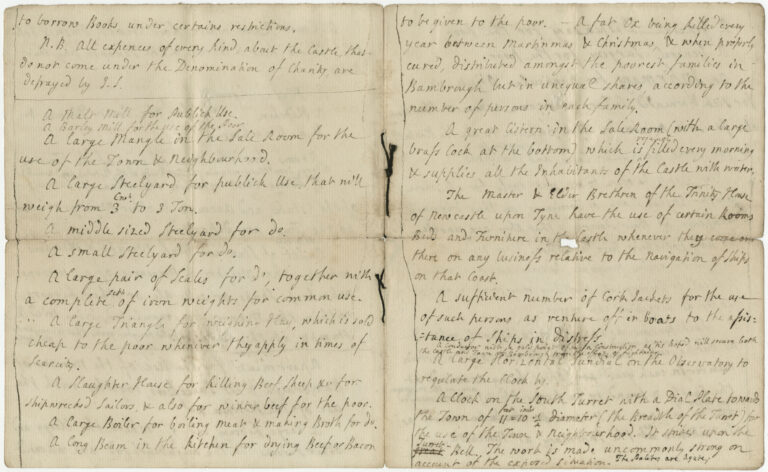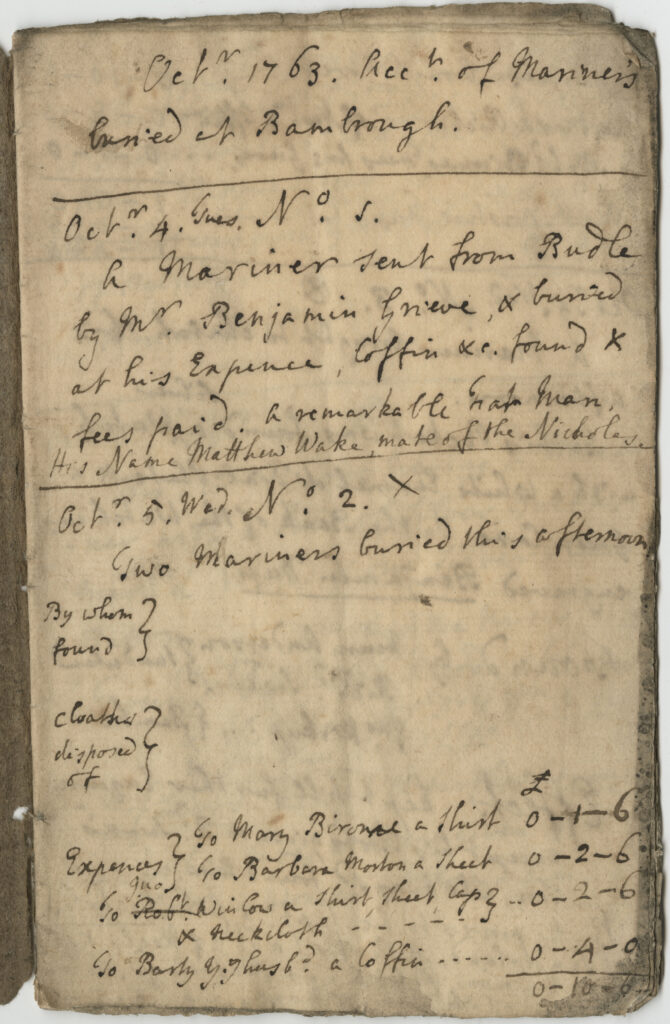SHIPWRECKS
CONTEXT
Concerned about the frequency of shipwrecks along the coast, Dr John Sharp appealed to the trustees of Lord Crewe’s Charity in February 1765 to provide assistance to shipwreck survivors. Following Dr Sharp’s request, the trustees sanctioned the introduction of two sets of measures. Firstly, the implementation of an 8-mile patrol of the coast on stormy nights. Secondly, the introduction of a signal gun which was fired during fog to warn ships away from the rocks.
Dr Sharp noted that some mariners and passengers of shipwrecked vessels managed to get to shore, only to lose their lives due to the severity of weather an inability to find suitable accommodation once ashore. To combat this, Dr Sharp rebuilt the ramparts and castle walls in order to set up accommodation for shipwrecked sailors. The sailors could stay at the castle for 7 days at the expense of the trustees. Survivors who did not need to stay at the castle were given food, water and a small amount of money.
In his letters to his manager Dr Sharp, George Hall frequently mentions finding bodies washed up on the beach at Bamburgh in the days following a storm. Bodies were inspected for clues of identity, and next of kin were attempted to be reached. They were buried in coffins made by the Bamburgh Castle carpenter.
In February 1769, the trustees approved the purchase of equipment to raise stranded ships. Dr Sharp compiled a stock of implements including screws, chains, grapple hooks, boat hooks and sea tongs, which were loaned to stranded ships to aid their recovery. By 1772, this had increased to include three pumps and cork jackets to be used to assist ships in trouble.
In 1789, Dr Sharp commissioned Lionel Lukin to construct the Lukin Boat in 1789, the first patented lifeboat in the world, making Bamburgh the first lifeboat station.
Prior to this, Lukin had been experimenting with designing an unsinkable boat which could withstand storms. Dr Sharp requested to use Lukin’s design to create a boat to be used to assist ships in trouble off the coast of Bamburgh. The idea was to adapt a coble, a flat-bottomed fishing boat traditionally used on the shallow shores of the north east. A coble was sent to Lukin, who modified his design specifications to suit the coble. Once returned to Bamburgh, the boat played a key role in future shipwreck rescue attempts.
DOCUMENTS
When bodies from shipwrecks were washed up ashore attempts were made to identify the deceased. Identification wasn’t always possible. The Charity organised and paid for the burial in Bamburgh Churchyard of unidentified bodies and of the remains of mariners whose families did not want their remains returned to them. Coffins were made by the carpenters at Bamburgh Castle. This is a sample page from a notebook detailing payment made for mariners’ burials. The page records burials organised in the early part of October 1763. The entry of 4 October relates to the burial of Matthew Wake, a mate on The Nicholas, whose body has been found at Budle. Matthew’s burial costs were met by Benjamin Grieve. On 5 October two unidentified mariners were buried. The notebook records that Barty Younghusband made the coffin at a cost of four shillings (twenty pence) and that shirts, sheets, a cap and neckcloth were made by Mary Bironel (?), Barbara Morton and Jno. Winlow at a total cost of 6 shillings and six pence (thirty-two and a half pence). The total cost of the two burials was ten shillings and six pence (fifty two and a half pence).
This is the last page of a diary kept by John Dial, schoolmaster, at Bamburgh Castle, in which he records details of wind and weather conditions. The page reads:
‘From this diary it appears that 865 vessels have passed through the fairway since 1st of January, viz. 455 to the Southward and 401 to the Northward.
The greatest height of the barometer was on the 2d of June 30.30. The height of the thermometer at that time being 64.00.
The document provides an indication of the shipping traffic that passed Bamburgh Castle in this period.
This document provides an account of events arising as a result of a great storm that took place on the night of 3 and 4 December 1774 that caused several ships with their cargoes to be run ashore on the section of Northumberland coast that fell under the jurisdiction of the Lord Crewe Charity. The Charity was entitled to any wreckage or cargo unless it a claim to it was made by another party. The document tells us that no bodies were found ashore and that some of the cargo was claimed by ‘some Scotch merchants’. In the early morning of 4 December a number of people began pillaging the wrecks despite efforts by the occupants of Bamburgh Castle to stop this.
The document includes an interesting observation about the local population claiming that it has been difficult to procure evidence of any theft because ‘few of the lower people in all the Villages along the Coast deem such Thefts Criminal’. Nonetheless, several local people were arrested, charged with theft and brought before the Quarter Sessions Court. However, the local Justices are uncertain that the case can be tried as a common law felony and how the goods should be described – as the property of the Lord Crewe Trustees or s wreck of the sea.
Legal opinion was sought from George Wood of Middle Temple and his advice is set out in this document. At the end of the document there is a sample indictment set out using the form of words advised.
FURTHER READING
The Charities of Nathaniel, Lord Crewe and Dr John Sharp 1721-1976 by CJ Stranks published by the Dean and Chapter of Durham 1976.
Memoirs of Nathaniel, Lord Crewe edited by Rev. Andrew Clark printed for the Camden Society 1893.
The Good Sharps by Hester Grant, Penguin Random House 2020
Dilston Hall…A Visit ot Bamburgh Castle with an account of Lord Crewe’s charties etc by WS Gibson published by Longman, Brown, Green and Longmans 1850
Dorothy and the Forsters of Bamburgh by John Bird, published by John Bird 1982
Bamburgh Belford Warenmouth Spindleston Outchester by Frank Graham published by Frank Graham 1976
Lord Crewe’s Charity website: https://www.lordcrewescharity.org.uk/
Northumberland Archives exhibition on Lord Crewe’s Charity: https://northumberlandarchives.com/exhibitions/crewe/1.html
Bamburgh Research Project website: https://bamburghresearchproject.wordpress.com/
Northumberland Archives blog on the electrifying machine: https://northumberlandarchives.com/2020/05/05/the-electrifying-machine-bamburgh-castle/
BBC Free Thinking feature on Bamburgh Castle surgery: https://dralun.wordpress.com/2015/11/02/bbc-free-thinking-feature-bamburgh-castle-surgery-c-1770-1800/
Article on overcrowded and underfunded 18th century hospitals: https://dralun.wordpress.com/2014/10/06/overcrowded-and-underfunded-18th-century-hospitals-and-the-nhs-crisis/
Article on 18th century medical jobs at Bamburgh Castle: https://dralun.wordpress.com/2014/01/22/do-you-need-a-doctor-applying-for-medical-jobs-in-the-eighteenth-century/
Article on 18th century medical job wages at Bamburgh Castle: https://dralun.wordpress.com/2014/01/24/negotiating-a-pay-rise-18th-century-style/
History Today article on Bamburgh Castle infirmary and dispensary: https://www.historytoday.com/hidden-hospital-bamburgh-castle-infirmary-and-dispensary
Article on Dr John Sharp: https://www.philanthropynortheast.com/the-philanthropists/sharp-dr-john
Bamburgh Bones website: https://bamburghbones.org/





